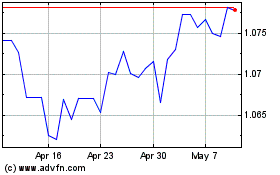Dollar Muted Amid Yellen's Testimony
September 28 2016 - 6:47AM
RTTF2
Wednesday, the U.S. dollar showed muted reaction to a speech by
the Fed Chair Janet Yellen before the Congress, indicating the
Fed's plan to impose stricter capital requirements on large U.S.
banks to cope up with the effects of a downturn.
"The existing capital conservation buffer would be replaced with
a risk-sensitive, firm-specific buffer that is sized based on
stress test results," prepared remarks for hearing before the House
of Representatives Financial Services Committee showed.
Yen gave little indication about the outlook for the economy or
monetary policy in her testimony.
Data from the Commerce Department showed that new orders for
U.S. manufactured durable goods came in flat in August, as a rise
in orders for transportation equipment was offset by decreases in
orders for other manufactured goods.
The Commerce Department said durable goods orders were virtually
unchanged in August after jumping by a revised 3.6 percent in
July.
Speaking at the Institutional Investor Conference in
Minneapolis, Minneapolis Fed President Neel Kashkari said that the
Fed should wait before raising borrowing costs.
He downplayed the view that strong job gains in a low rate
environment could create inflationary pressures.
The greenback was trading higher against most major counterparts
in European trading.
The greenback, having advanced to 1.2981 against the pound at
4:00 am ET, retreated to a 5-day low of 1.3032 in a short while and
held steady thereafter. The pair closed yesterday's trading at
1.3022.
Bank of England Deputy Governor Minouche Shafik said more easing
will be required at some point to ensure that a slowdown in
economic activity does not turn into more pernicious.
The UK faces a sizeable economic shock in the wake of the
referendum.
The greenback held steady against the euro with the pair trading
at 1.1211, after easing from its early European session's weekly
high of 1.1182. The euro-greenback was valued at 1.1209 when it
ended Tuesday's deals.
While speaking to European Affairs committee in Berlin, Draghi
defended the ECB's negative rate policy, saying the present low
rate-regime would help to return higher interest rates in the
future.
"Our monetary policy has supported growth and employment and
will eventually bring inflation back to our aim," he added.
The greenback eased back to 0.9691 against the Swiss franc, off
its early 5-day high of 0.9742. At yesterday's close, the pair was
valued at 0.9707.
Survey data from the investment bank UBS showed that Swiss
consumption indicator climbed in August on the back of a resurgence
in tourism and above-average car sales.
The UBS Consumption Indicator rose to 1.53 points from 1.45 in
July, which was revised from 1.32.
Following an advance to 100.82 against the Japanese yen at 4:00
am ET, the greenback edged down slightly to 100.45. On the
downside, the greenback may locate support around the 99.00
mark.
Survey figures released by the Shoko Chukin Bank revealed that
Japan's small business confidence improved more than expected in
September.
The small business sentiment indicator climbed to 47.7 in
September from 46.3 in the prior month. The reading stayed above
the expected level of 47.
Looking ahead, at 4:30 pm ET, Federal Reserve Bank of Cleveland
President Loretta Mester is scheduled to speak before the Greater
Cleveland Partnership, in Cleveland.
Euro vs US Dollar (FX:EURUSD)
Forex Chart
From Mar 2024 to Apr 2024

Euro vs US Dollar (FX:EURUSD)
Forex Chart
From Apr 2023 to Apr 2024
